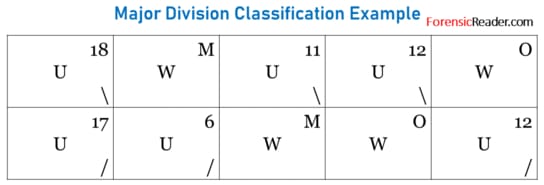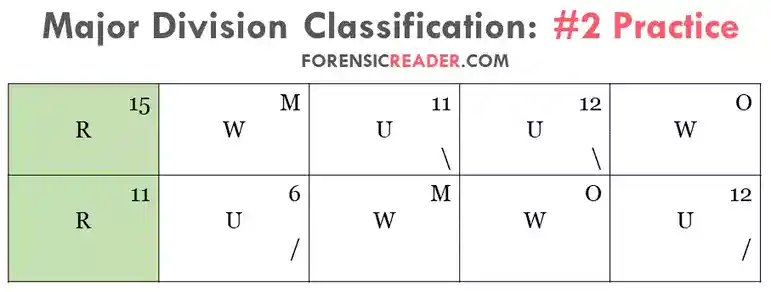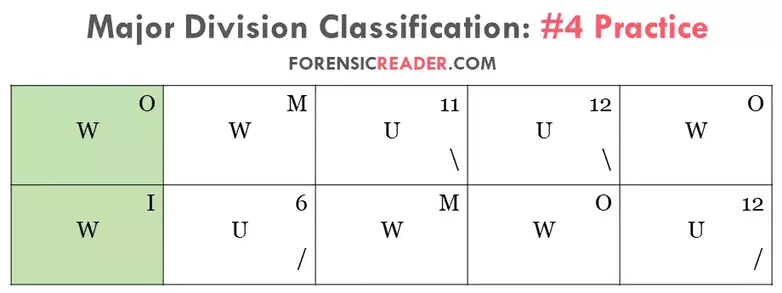Major classification is a subdivision of the Henry Fingerprint system (FBI modified) whose values are set in between the key division and primary division. Their values are based on the pattern present on the thumbs (number 1 and number 6 fingers).
In this article, you’re going to know in-depth information on how to calculate the major division values, classification in scarred and amputated fingers with a practice worksheet followed by frequently asked questions.
Rules for Major Classification System
- Numerator: Right thumb value (finger 1)
- Denominator: Left thumb (finger 6)
- Position: placed immediately to the left of the primary classification column.
- Patterns: Loops and Whorls
- Values: Ridge tracing and Ridge counting
- If the pattern is a loop, ridge counting is obtained.
- For whorl patterns, ridge tracing is considered.
Major Division Not Employed in:
1. Arches: When plain and tented arches are on thumb fingers, major classification is not used.
2. Small Letter Grouping: In case, small letter grouping is present with secondary division values, both sub secondary, and major division are omitted.
Values of Major Division Classification System
To evaluate the value of major classification, ridge counting and ridge tracing are performed for loops and whorls, respectively.
Values for Loops
The values of loop counts are represented by small (S), medium (M), or large (L).
While evaluating loops value, you should first count the loops in the left thumb followed by the right thumb.
This is because, for the right thumb finger, there are two value sets. And the right thumb value system is chosen based on the ridge count of the left thumb finger.
That’s the reason why you should first come up with the values of the loop of the left thumb (number 6 finger).
Loop Count Values for the Left Thumb
The left thumb (no. 6 fingers) has only one set of values for loops. These are:
- Small (S): 1 to 11
- Medium (M): 12 to 16
- Large (L): 16+
Loop Count Values for the Right Thumb
Case 1: Ridge count of the left thumb is 16 or less
In this case, you can use the same values of the left thumb i.e.
- Small (S): 1 to 11
- Medium (M): 12 to 16
- Large (L): 16+
Case 2: Ridge count of Left thumb is greater than 16
For this, new sets of values are assigned for the right thumb:
- Small (S): 1 to 17
- Medium (M): 18 to 22
- Large (L): 22+
Table: Loop Counts Value for Numerator and Denominator
| Left Thumb Denominator | Right Thumb Numerator |
|---|---|
| 1 to 11= S (small) | • 1 to 11= S (small) • 12 to 16= M (medium) • 16+ = L (large) |
| 12 to 16= M (medium) | • 1 to 11= S (small) • 12 to 16= M (medium) • 16+ = L (large) |
| 16+ = L (large) | • 1 to 17= S (small) • 18 to 22= M (medium) • 22+ = L (large) |
Why Right Thumb has Two sets of Major Division Value?
Wonder! why there are two sets of values for the right thumb?
The simple answer is to distribute prints more evenly in major classifications.
But how?
As thumbs have the highest areas, so the majority of loops counts usually have values higher than 15. This means the values majorly belong to medium (M) and large (L) groups.
That makes the medium (M) and large (L) groups more filled and populated than the small (S) group. Therefore, left-hand prints majorly fall in-group ‘M’, and ‘L’.
Now, let’s assume if the right-thumb value also falls in the ‘M’ and ‘L’ ranges, these groups are more intensely populated. To overcome with intensely populated groups, right-hand values are brought ahead to:
- 1-17= Small
- 18-22= Medium
- 22+= Large
This arrangement gives more equitably group values.

Note 1: If the left thumb has a whorl pattern, then the case 1 value set is employed for ridge counting of the right thumb (check practice #3, later the post).
Values for Whorls
Whorl traces are represented in capital Inner (I), Meeting (M), and Outer (O). Following are the respective values;
- Meeting (M) = 0, 1, or 2 ridges inside or outside the right delta
- Inner (I) = 3 or more inside the right delta.
- Outer (O) = 3 or more outside the right delta
Procedure For Major Division Classification
Let’s calculate the major division number using the following example.
For example: The following is a fingerprint card that has a thumb impression of ulnar loops on both hands where the LT count is more than 16.

Step 1: Finding Patterns in Thumb
1. Left Thumb: Left Slant Loop (/).
- Left Slant loop in left hand= Ulnar Loop.
- Ridge Count: 17
2. Right Thumb: Right Slant Loop (\).
- Right Slant loop in right hand= Ulnar Loop.
- Ridge Counting: 18
Step 2: Finding Value for Left Thumb
- Ridge Count: 17 (as per table, the value is greater than 16)
- Major division value for LT: L
Step 3: Finding Value for Right Thumb
- Ridge Count: 18
- If the left thumb value is greater than 16, case 2 values are used.
- Major division value for RT: M
Step 4: Representing in Henry Fingerprint System
Based on the above values, henry classification number would be:
| Key | Major | Primary | Secondary | Sub Secondary | Final |
| Yet to find | M | 19 | W | MOI | Yet to find |
| L | 6 | U | IMO |
Read More: National Crime Information Center (NCIC) Fingerprint Classification
Major Classification for Scarred and Amputated Fingers
There are various rules that are needed to address while interpreting the classification of scarred and amputated finger ridges. Let’s have a look one by one.
A. Scarred Fingerprints
The following table is only used for the evaluating value of major classification of scarred fingerprints.
| Possible Rule | Values |
|---|---|
| Rule 1: Fully Disfigured Impressions | Patterns from corresponding opposite thumb |
| Rule 2: Partially scarred with possible known pattern type but inconclusive ridge count/trace | • If the same general pattern on opposite thumb: Ridge count/trace value of opposite thumb. • If different general patterns: probable count/trace value assigned. |
| Rule 3: Partially scarred with inconclusive pattern (whorl/loop) but possible ridge count/trace | Ridge counting/tracing of partially scarred thumb with the opposite thumb pattern type |
| Rule 4: Both corresponding opposite thumbs are fully disfigured | Whorls pattern with meet trace value (M/M) |
Note 2: If the thumb has a bandage, prints are taken after healing. If healing leads to scars, the values are given by the above-stated rules.
B. Amputated Fingers
The following table is strictly for classifying major division values for amputated fingers.
| Possible Rule | Values |
|---|---|
| Rule 1: Amputated Thumb | Patterns from corresponding opposite thumb |
| Rule 2: Both thumbs are Amputated | Whorls pattern with meet trace value (M/M) |
| Rule 3: All fingers are Amputated | M/M |
| Rule 4: Both Hands are Amputated | Footprints are used |
Practical Worksheet for Finding Major Division Number
Here, I listed four common cases that help you understand the major division of fingerprints in more detail. So, try to go through all these four practices.
Practice Set #1: Ulnar Loops with LT<=16
The following is the given 10-digit card where left thumb counting is less than or equal to 16.

As per the above example:
1. Left Thumb: Left Slant Loop (/).
- Left Slant loop in left hand= Ulnar Loop
- Ridge Count: 15
2. Right Thumb: Right Slant Loop (\).
- Right Slant loop in right hand= Ulnar Loop
- Ridge Counting: 18
Step 1: Finding Value for Left Thumb
- Ridge Count: 15 (value 12 to 16= M)
- Major division value for LT: M
Step 2: Finding Value for Right Thumb
- Ridge Count: 18 (same system as LT, because LT is lower than 16)
- Major division value for RT: L
Step 3: Representing in Henry Fingerprint System
- Numerator= Right Thumb= L
- Denominator= Left Thumb= M
Practice Set #2: Radial Loops with LT<16

As per the above example:
1. Left Thumb:
- Loop type= Radial Loop
- Ridge Count: 11
2. Right Thumb:
- Loop Type= Radial Loop
- Ridge Counting: 15
Step 1: Finding Value for Left Thumb
- Ridge Count: 11 (value 1 to 11 = S)
- Major division value for LT: S
Step 2: Finding Value for Right Thumb
- Ridge Count: 15 (same system as LT)
- Major division value for RT: M
Step 3: Major Classification Number
- Numerator= Right Thumb= M
- Denominator= Left Thumb= S
Practice Set #3: One Loop and One Whorl

As per the above example:
1. Left Thumb: Whorl
- Ridge Tracing: 4, inside delta
Please Note: Instead of writing ridge counting in a 10 digit card, the values of whorls are directly needed to be written in their corresponding values (‘I’, ‘M’, or ‘O’). You can check our dedicated article on how to fill a 10-digit card.
2. Right Thumb: Left Slant Loop (/).
- Left Slant loop in right hand= Radial Loop
- Ridge Counting: 16
Step 1: Finding Value for Left Thumb
- Ridge Tracing: 4 (‘I’ = 3 or more inside right delta)
- Major division value for LT: I
Step 2: Finding Value for Right Thumb
- Ridge Count: 16 (12 to 16 = M)
- Major division value for RT: M
Step 3: Major Classification Number
- Numerator= Right Thumb= M
- Denominator= Left Thumb= I
Practice #4: Both Whorls

As per the above example:
1. Left Thumb: Whorl
- Ridge Tracing: 4, inside right delta
2. Right Thumb: Whorl
- Ridge Tracing: 3, outside right delta
Step 1: Finding Value for Left Thumb
- Ridge Tracing: 4, inside delta (‘I’ = 3 or more inside right delta)
- Major division value for LT: I
Step 2: Finding Value for Right Thumb
- Ridge Tracing: 3 (‘O’ = 3 or more outside right delta)
- Major division value for RT: O
Step 3: Major Classification Number
- Numerator= Right Thumb= O
- Denominator= Left Thumb= I
Related Questions
1. What fingers are used for obtaining the major classification?
Ans. Finger Number 1 (right thumb) and Finger number 6 (left thumb) are used for obtaining major classification values.
2. In interpreting a loop pattern, what is the numerical value of ‘M’ in the left hand in the major division?
Ans. For the loop patterns in the left-hand thumb, the value of ‘M’ in the major division lies between 12 to 16. and for the right thumb, it might be 12 to 16 or 28 to 22.
2. What if loops and whorls patterns are not found in both thumbs, how is major classification obtained?
Ans. In case, when loops and whorls are absent on the right and left thumb, the major classification system is omitted out.
3. If ridge counts appearing on the right thumb is 17 and the ridge counts on the left thumb are 22, what is the major classification?
Ans. As the ridge counts on the right thumb and left thumb are 17 and 22 respectively, the major division value is S/L. First, the value of the left thumb is 22 which is given by Large ‘L’. If the left thumb value is greater than 16+, case2 values are used. Therefore, the major division value of the right thumb is given by Small ‘S’. That’s why S/L.
4. At what instance, the denominator governs the numerator in the major classification?
Ans. The denominator is important in the case of loops. This is due to the fact that the right thumb has two sets of values that are determined by the value of the left thumb’s ridge count.
Also Read:
- Extensions of Henry Fingerprint System: WCDX & Special Loops
- Sub Secondary Classification of Fingerprints: Rules, Calculation, And Example
- Final Classification of Fingerprint: Rules, Worksheet, and Amputated Fingers
- Key Classification of Fingerprint: Rules, Procedure, & Example
- Second Sub Secondary Classification of Fingerprint: Rules, Procedure & Example

FR Author Group at ForensicReader is a team of Forensic experts and scholars having B.Sc, M.Sc, or Doctorate( Ph.D.) degrees in Forensic Science. We published on topics on fingerprints, questioned documents, forensic medicine, toxicology, physical evidence, and related case studies. Know More.
